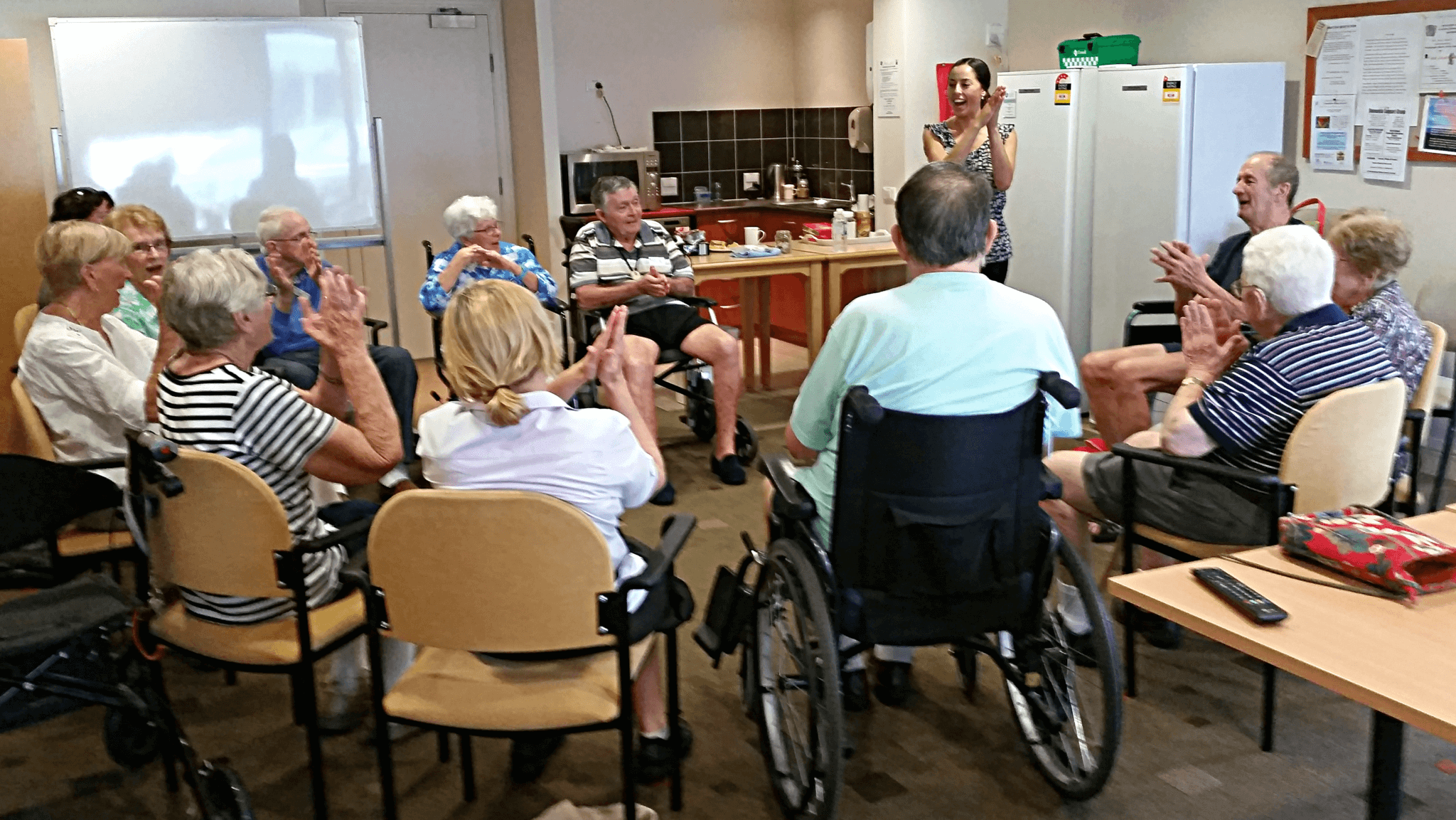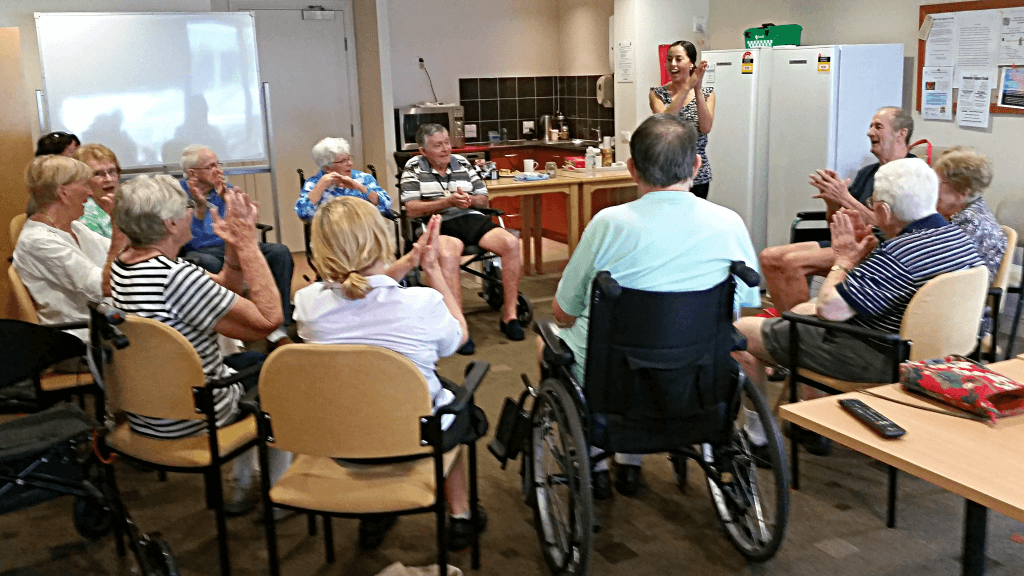
11 Mar Laughter As A Complementary Therapy For People With Parkinson’s – Outcomes Of A First Class
My recent article Laughter As A Complementary Therapy For People With Parkinson’s shared information about how a therapeutic approach to laughter, such as laughter yoga, may benefit people living with Parkinson’s. The article was written in preparation for a laughter yoga class with a Parkinson’s Support Group. The class was recently conducted and various benefits were observed, including some benefits that I had not originally contemplated.
This article provides anecdotal evidence gathered through observations during the class, as well as personal interviews with participants afterwards. Two interviews were conducted by me, with participants who were keen to speak with me. The rest were conducted by the Group Facilitator two days later, whom I also later interviewed.
The laughter yoga class involved 12 participants including:
- 7 people living with Parkinson’s
- 3 carers (spouses)
- The Facilitator of the Parkinson’s Support Group, a care administrator at the retirement village where the session took place, whose father also has Parkinson’s
- 1 visitor, who joined the class half-way through
At the start of the class, it was important to establish safety within the group. Participants were encouraged to do the best they could and if something didn’t feel comfortable, to do what felt right for them or just smile and enjoy the sound of laughter around them. Early on, a participant joked that the group may be laughing at him. It was also important to establish that in laughter yoga, we laugh with people, not at them. We can laugh at ourselves or with someone who is laughing at him or herself, but not at people because that does not spread joy.
At the start of the class and at the end of the class, participants were asked to close their eyes, notice how they felt and to rank how they felt on a scale of 1-10 with one being the lowest and ten being the highest. Here is some of the feedback shared by participants:
- ‘‘There was something for everyone. It took me a while to get warmed up but I liked everyone’s enthusiasm.’’
- ‘‘I liked that the whole group came together. My score went up.’’
- ‘‘I thought that the exercises were good, beneficial and I found it a positive experience.’’
- ‘‘I came in feeling really down. When you came in and made us laugh, it was hard at first. Especially with Parkinson’s, you feel like your smile is forced. I came in here feeling a 4/10. After I felt a 7 or an 8. It seemed to relax me. The whole group relaxed. They lost their embarrassment and engaged readily. I found the laughter very infectious.’’
The Group Facilitator, who invited me to present to the group, observed several benefits of the laughter class. For example, it was seen to:
Improve Mood
‘‘With chronic illness, it’s doom and gloom all the time. When you have an allied health professional come in, they often talk about the negative symptoms of the condition. People in the group may think, ‘Is that going to happen to me?’ The laughter session lifted the mood and brought the group together.’’
Reduce Anxiety
Laughter yoga involves laughter exercises and deep breathing techniques that lower cortisol (stress hormone) levels in the body and activate the body’s relaxation response. According to the Group Facilitator, ‘‘The most crippling part of Parkinson’s can be the anxiety. Laughter yoga focuses on positive ways of managing symptoms.’’
Provide Rhythm through Rhythmic Clapping
Laughter yoga also involves rhythmic clapping. One of the clapping exercises is to the rhythm of ho ho, ha ha ha – which are sounds that come from the diaphragm. The Group Facilitator said, ‘‘People who freeze need a rhythm. When someone freezes, we get beside them and we march to the rhythm of 123, 123 and this helps them to get moving again. I suspect the rhythm of the clapping may help in the same way and reduce freezing.’’
Increase Voice Volume
Symptoms of Parkinson’s may include speech and voice disorders, such as speaking with a soft voice. The Group Facilitator felt that the deep breathing exercises and laughter exercises, that encouraged participants to use the diaphragm, were helpful. She said, “Laughing from the diaphragm encouraged people to increase their volume or maintain their volume because they have to use the diaphragm to increase volume.’’
Initiate Movement
Certain laughter exercises involve safe, physical contact such as a handshake. The Group Facilitator stated, ‘‘People with Parkinson’s may have trouble initiating movement. By you reaching out to shake someone’s hand, that initiates movement.’’
Exercise Facial Muscles
Another symptom of Parkinson’s is decreased facial expression or ‘masked face’ and people may find it difficult to use their facial muscles. ‘‘Getting people to laugh encourages them to use their facial muscles. It shows you can laugh even though you may not be able to use all the facial muscles’’, the Group Facilitator expressed.
None of the participants reported any negative feelings from the session.
One particular participant needed to leave the session promptly due to his routine, so I was not able to speak with him afterwards. I was however, able to speak with his wife. She said, ‘‘With Parkinson’s, you can’t express what you really feel. People say ‘Look at that angry man out there.’ When this participant shared his feedback with the Group Facilitator days later, he said, ‘‘I loved the hand exercises. My mood was up and I thought about the session all of that day and the next.’’ In addition, he wanted to pass the following document A Letter For My Friends onto me and I would like to share it too.
It was clear from this initial session that the overall mood of the group improved and many group members reported that they had a positive experience. From this experience, it seems that further research on Laughter as a Complementary Therapy for People Living with Parkinson’s would be beneficial, particularly to determine whether the results could be sustained over a period of time.
SOURCE:
A Letter For My Friends – Parkinson’s NSW
Laugh and Live Well is pleased that this article has been published as a guest post by the Laughter Online University, a world leader of laughter online education.
For more information about What the laughter session looked like click here:




No Comments